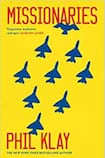
Phil Klay’s first novel takes a line from Seamus Heaney’s Kinship as an epigraph: “Report us fairly, how we slaughter / for the common good.” It’s a theme continued from Redeployment (2014), Klay’s National Book Award-winning short-story collection based on his service in Iraq. As one of the characters in Redeployment remarks, whatever a soldier may think of foreign policy, “you risked your life for something bigger than yourself... You held up your hand and said, ‘I’m willing to die for these worthless civilians.’”
Klay dedicated six years to researching Missionaries. The book is set predominantly in Colombia, where the US has long offered military and financial aid, first as part of the war on drugs and then in the name of counter-terrorism after 9/11.
The first half of the novel, spanning three decades, is narrated in turn by its four main characters. We follow the stories of Abel, a young man forced to join a paramilitary group after his village is destroyed by guerrilla forces; Lisette, a jaded war correspondent; Juan Pablo, a second-generation Colombian military officer; and Mason, a medic in Afghanistan reassigned as a Special Forces liaison in Colombia. Having asked to be transferred to “any wars right now where we’re not losing”, Lisette lands in Colombia as well, where she is kidnapped while chasing a story lead in coca country.
Intersect
The second part of the novel shifts to third-person narration as the lives of the main characters, as well as a cast of secondary characters whom we’ve met along the way, intersect over Lisette’s being taken hostage, and the plot picks up pace. Juan Pablo’s daughter, Valencia, who is volunteering in the region, recording testimonies of victims of the guerrillas, finds herself face to face with Abel’s warlord boss. Juan Pablo’s efforts to protect her pull him unwittingly into the drama. Mason, who was inadvertently the source of the tip that led Lisette to travel into a dangerous zone, tries to help Diego, her contractor friend and sometimes lover, track her down.
Klay clearly understands the complexities of the Colombian conflict, with its ever-shifting alliances
The denouement unfolds against the backdrop of negotiations of the 2016 peace treaty between the Colombian government and the Farc guerrillas, which hoped to bring a half-century of civil war to an end. The treaty was not, alas, a panacea.
“Despite the international news declaring an end to ‘the longest insurgency in history’,” warns Juan Pablo, “it is critical that all parties involved understand that ‘war’, loosely understood, continues in Colombia.” (Indeed, while Farc retreated, coca production remains at record highs and the New York Times reports that “paramilitaries and criminal gangs, also lured by cocaine profits, dominate regions where Farc once held sway.”)
Klay clearly understands the complexities of the Colombian conflict, with its ever-shifting alliances between “paracos and guerrillas and narcos and bandits and police and soldiers and even a few smaller groups” – all further divided into factions and corrupted by the drug trade. He does not shy away from the brutalities of war: we get the sounds of a local mayor being chain-sawed in half and graphic scenes of Mason tending to the wounded – replete with intestines on display and an aorta pulsing under his fingers.
Intimacy
In addition to such evocative imagery, Klay touchingly relays the difficulties of maintaining intimacy with civilians while deployed. Mason and his wife agree to share “the real stuff” in letters rather than on the phone so as not to put “the other person in the position of having to respond to whatever intense shit we were going through, whether it was our daughter or money or combat, in real time”.
The unspooling of Klay’s exhaustive research can get exhausting, however. The first section drags, lacking the sniper focus of his short stories, particularly for Abel, whose story pulls heartstrings but whose character never feels fully formed.
While exposing the sprawling web of American counter-terrorist warfare is an admirable aim, musings on military policy placed in the mouths and minds of the characters are heavy-handed: “This was an extension of the same war,” Lisette tells herself, “not the endless war on ‘terror’ but something vaguer, harder to pin down and related to the demands of America’s not-quite-empire, which was always projecting military power across the globe and just shifting the rationale of why.”
Such reflections (this example goes on for a page) are superfluous; the brutality that Klay depicts so vividly is proof enough that there is no such thing as a “good war”.














